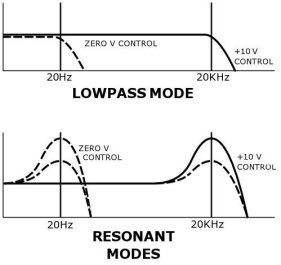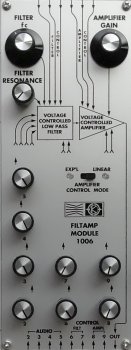
1006
FiltAmp
MOS-LAB 1006 contains a four-input mixer, a voltage controlled low-pass filter, plus a voltage controlled amplifier with associated circuitry. A resonance or ”peaked” response at the cutoff frequency of the low-pass filter may be obtained if so desired. This is useful for creating certain types of formants, such as ”wa-wa” or ”yeow” effects.
The voltage controlled amplifier may be operated in one of two selectable modes. The exponential mode has a control transfer function of 10 dB per virtual volt. The linear mode has a control function, so Vout goes from silence with the amplifier gain in the extreme counter-clockwise position to Vin with the amplifier gain in the extreme clockwise position.
The range of the voltage controlled amplifiers is over 100 dB, which permits the VCA to be used as a squelch gate control device. By proper adjustment of controls no discernible output should be obtained in the absense of control voltages, even when the audio inputs are operated at maximum levels.
Inputs
There are three separate filter control inputs at the top of the module and two at the bottom. The three at the top are fixed in sensitivity (like the 1004 oscillator) at 1 volt/octave.
The inputs from the bottom of the module are each associated with an attenuator (”2” to ”5”). With the attenuators rotated fully clockwise, the sensitivity of these inputs is also 1 volt/octave. The voltage appearing at each control input are summed internally and the cutoff frequency of the filter will be determined by this sum. Although the sum of all the control inputs may exceed the effective input range of the filter, (i.e., +10 volt), no damage can be done to the circuitry by such overdrive. Like with the filter, there are three separate amplifier control inputs at the top of the module and two at the bottom.
Controls
Top left is the filter fc control knob to set the filter cutoff frequency, and below that the filter resonance control knob, which control the height of the resonant peak. In the upper right is the control knob to manually set the gain of the voltage controlled amplifier. Like on the MOS-LAB 1005 Module, a panel slide switch gives the user the choise of linear or exponential control modes. Four control knobs (labelled ”2” to ”5”) are used to attenuate the four audio inputs from the bottom of the module. Two control knob (labelled ”6” and ”7”) are used to attenuate the two filter control inputs from the bottom of the module. And finally two control knobs (labelled ”8” and ”9”) are used to attenuate the two amplifier control inputs from the bottom of the module.
Outputs
A single output is in the lower right corner of the module. This is the result after the four audio signals are mixed, sent through first the filter section and then the amplifier both controlled by control signals and manual control by adjusting the knobs.
TECHNICAL SPECIFICATIONS
FILTER :
24 dB/octave attenuation, 20 Hz - ∼48 kHz (Nyquist frequency) unity gain in passband.
Control Inputs: 0 to +10 volt operating range. Sensitivity: 1 volt/octave, 0 volt = 20 Hz.
Filter Resonance: 0 to 20 dB peak.
AMPLIFIER :
(Response: ±3 dB, 2 Hz to 30 kHz.)
Maximum Gain: Unity.
Maximum Attenuation: Infinite.
Control Inputs: 0 to +10 volt operating range.
Sensitivity: 10 dB attenuation per volt (Amplifier Control in Exponential Mode).
In Linear Control Mode, 0 to Unity.
AUDIO OUTPUT :
±10 volt max.
AUDIO INPUTS :
±10 volt max. after attenuators.





